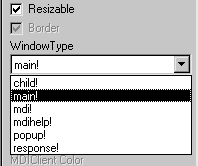Use the General property page to specify the following window information:
Window type
Title bar text
Menu name
Color
Transparency
Animation
The first thing you should do is specify the type of window you are creating.
![]() To specify the window's type:
To specify the window's type:
In the Properties view for the window, select the General tab.
Scroll down the property page and select the appropriate window type from the WindowType drop-down list.

Depending on the type of window, PowerBuilder enables or disables certain check boxes that specify other properties of the window. For example, if you are creating a main window, the Title Bar check box is disabled. Main windows always have title bars, so you cannot clear the Title Bar check box.
By selecting and clearing check boxes on the General property page, you can specify whether the window is resizable or minimizable, is enabled, has a border, and so on.
Note the following:
A main window must have a title bar.
A child window cannot have a menu.
A response window cannot have a menu, Minimize box, or Maximize box
.
Many of your windows will have a menu associated with them.
![]() To associate a menu with the window:
To associate a menu with the window:
Do one of the following:
Enter the name of the menu in the Menu Name text box on the General property page
Click the Browse button and select the menu from the Select Object dialog box, which displays a list of all menus available to the application
Click the Preview button in the PainterBar to see the menu.
For information about preview, see “Viewing your work”.
![]() Changing the menu
You can change a menu associated with a window during execution
using the ChangeMenu function. For more information,
see the PowerScript Reference.
Changing the menu
You can change a menu associated with a window during execution
using the ChangeMenu function. For more information,
see the PowerScript Reference.
You can change the background color of your window.
![]() To specify the color of a window:
To specify the color of a window:
Do one of the following:
Specify the color of the window from the BackColor drop-down list on the General property page.
If the window is an MDI window, specify a color in the MDI Client Color drop-down list
.
For main, child, pop-up, and response windows, the default color is ButtonFace if you are defining a 3D window, and white if you are not. If you or the user specified different display colors in the Windows Control Panel, a 3D window will display in the color that is set for the window background.
You can change the default for windows that are not 3D in the Application painter Properties view. To do so, click the Additional Properties button on the General page and modify the Background color on the Text Font tab page. New windows that are not 3D will have the new color you specified.
For more about using colors in windows, including how to define your own custom colors, see Chapter 12, “Working with Controls.”
If the window can be minimized, you can specify an icon to represent the minimized window. If you do not choose an icon, PowerBuilder uses the application icon for the minimized window.
![]() To choose the window icon:
To choose the window icon:
Click the window's background so the Properties view displays window properties.
Select the General tab.
Choose the icon from the Icon drop-down list or use the Browse (...) button to select an icon (.ICO) file.
The icon you chose displays in the Icon list.
![]() Changing the icon at runtime
You can change the window icon at runtime by assigning in
code the name of the icon file to the window's Icon property, window.Icon.
Changing the icon at runtime
You can change the window icon at runtime by assigning in
code the name of the icon file to the window's Icon property, window.Icon.
You can specify a value between 1 and 100% for the Transparency property of a window. This property is useful if you want a non-modal dialog box to remain visible but become semi-transparent when it loses focus.
You can use a special effect when a window opens or closes. Effects include fading in or out, opening from the center, and sliding or rolling from the top, bottom, left, or right. You specify animation effects with the OpenAnimation, CloseAnimation, and AnimationTime properties. Set the AnimationTime property to between 1 and 5000 milliseconds to specify how long the animation effect takes to complete.
For example, if your application displays a splash screen while the application’s main window is initializing, you can set the splash screen’s CloseAnimation property to have the window fade out rather than just disappearing when the application is initialized or after a timeout by setting the CloseAnimation property to FadeAnimation!.